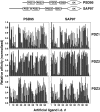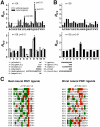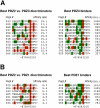The PDZ domain as a complex adaptive system
- PMID: 17895993
- PMCID: PMC1978516
- DOI: 10.1371/journal.pone.0000953
The PDZ domain as a complex adaptive system
Abstract
Specific protein associations define the wiring of protein interaction networks and thus control the organization and functioning of the cell as a whole. Peptide recognition by PDZ and other protein interaction domains represents one of the best-studied classes of specific protein associations. However, a mechanistic understanding of the relationship between selectivity and promiscuity commonly observed in the interactions mediated by peptide recognition modules as well as its functional meaning remain elusive. To address these questions in a comprehensive manner, two large populations of artificial and natural peptide ligands of six archetypal PDZ domains from the synaptic proteins PSD95 and SAP97 were generated by target-assisted iterative screening (TAIS) of combinatorial peptide libraries and by synthesis of proteomic fragments, correspondingly. A comparative statistical analysis of affinity-ranked artificial and natural ligands yielded a comprehensive picture of known and novel PDZ ligand specificity determinants, revealing a hitherto unappreciated combination of specificity and adaptive plasticity inherent to PDZ domain recognition. We propose a reconceptualization of the PDZ domain in terms of a complex adaptive system representing a flexible compromise between the rigid order of exquisite specificity and the chaos of unselective promiscuity, which has evolved to mediate two mutually contradictory properties required of such higher order sub-cellular organizations as synapses, cell junctions, and others--organizational structure and organizational plasticity/adaptability. The generalization of this reconceptualization in regard to other protein interaction modules and specific protein associations is consistent with the image of the cell as a complex adaptive macromolecular system as opposed to clockwork.
Conflict of interest statement
Figures





Similar articles
-
Structure function relations in PDZ-domain-containing proteins: Implications for protein networks in cellular signalling.J Biosci. 2018 Mar;43(1):155-171. J Biosci. 2018. PMID: 29485124 Review.
-
The cytoplasmic domain of NrCAM binds to PDZ domains of synapse-associated proteins SAP90/PSD95 and SAP97.Eur J Neurosci. 2006 Jul;24(1):25-31. doi: 10.1111/j.1460-9568.2006.04899.x. Eur J Neurosci. 2006. PMID: 16882004
-
A functional network of the tumor suppressors APC, hDlg, and PTEN, that relies on recognition of specific PDZ-domains.J Cell Biochem. 2012 Aug;113(8):2661-70. doi: 10.1002/jcb.24141. J Cell Biochem. 2012. PMID: 22434720
-
Protein kinase Cα promotes cell migration through a PDZ-dependent interaction with its novel substrate discs large homolog 1 (DLG1).J Biol Chem. 2011 Dec 16;286(50):43559-68. doi: 10.1074/jbc.M111.294603. Epub 2011 Oct 25. J Biol Chem. 2011. PMID: 22027822 Free PMC article.
-
PDZ domain-phosphoinositide interactions in cell-signaling.Verh K Acad Geneeskd Belg. 2006;68(4):271-86. Verh K Acad Geneeskd Belg. 2006. PMID: 17214441 Review.
Cited by
-
A flexible docking scheme to explore the binding selectivity of PDZ domains.Protein Sci. 2010 May;19(5):914-28. doi: 10.1002/pro.366. Protein Sci. 2010. PMID: 20196074 Free PMC article.
-
Learning Sequence Determinants of Protein:protein Interaction Specificity with Sparse Graphical Models.Res Comput Mol Biol. 2014;8394:129-143. doi: 10.1007/978-3-319-05269-4_10. Res Comput Mol Biol. 2014. PMID: 25414914 Free PMC article.
-
Interleukin-1 receptor type 1 is overexpressed in neurons but not in glial cells within the rat superficial spinal dorsal horn in complete Freund adjuvant-induced inflammatory pain.J Neuroinflammation. 2017 Jun 23;14(1):125. doi: 10.1186/s12974-017-0902-x. J Neuroinflammation. 2017. PMID: 28645297 Free PMC article.
-
Leveraging industrial-technological innovation to achieve sustainable development: A systems thinking perspective.PLoS One. 2020 Dec 21;15(12):e0242981. doi: 10.1371/journal.pone.0242981. eCollection 2020. PLoS One. 2020. PMID: 33347480 Free PMC article.
-
Structure function relations in PDZ-domain-containing proteins: Implications for protein networks in cellular signalling.J Biosci. 2018 Mar;43(1):155-171. J Biosci. 2018. PMID: 29485124 Review.
References
-
- Kuriyan J, Cowburn D. Modular peptide recognition domains in eukaryotic signaling. Annu Rev Biophys Biomol Struct. 1997;26:259–288. - PubMed
-
- Sudol M. From Src Homology domains to other signaling modules: proposal of the ‘protein recognition code’. Oncogene. 1998;17:1469–1474. - PubMed
-
- Castagnoli L, Costantini A, Dall'Armi C, Gonfloni S, Montecchi-Palazzi L, et al. Selectivity and promiscuity in the interaction network mediated by protein recognition modules. FEBS Lett. 2004;567:74–79. - PubMed
-
- Kay BK, Kasanov J, Knight S, Kurakin A. Convergent evolution with combinatorial peptides. FEBS Lett. 2000;480:55–62. - PubMed
-
- Zucconi A, Panni S, Paoluzi S, Castagnoli L, Dente L, et al. Domain repertoires as a tool to derive protein recognition rules. FEBS Lett. 2000;480:49–54. - PubMed
Publication types
MeSH terms
Substances
Grants and funding
LinkOut - more resources
Full Text Sources

